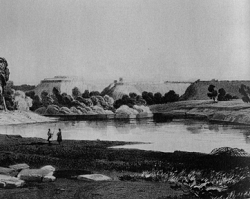The Old Spanish Trail brought trade to Utah

During the century before Father Edward Kelly established the first Catholic parish in Utah in 1866, there was an almost constant presence of Catholics in the region. It was a transient population of missionaries, explorers, soldiers, trappers and traders. Their contribution to Utah history, though, was not insignificant, and in fact one of their enterprises – the Old Spanish Trail – placed Utah at the center of an international commercial network that brought trade goods from California and even China to Santa Fe and, via the Santa Fe Trail, to St. Louis and to markets in the East. The Old Spanish Trail linking Santa Fe and Los Angeles was not actually Spanish, for the route was not established until 1829, well after the Mexican Revolution of 1821. The Spanish government had, with few exceptions, discouraged such ventures into the northern hinterlands because they risked stirring up Indian troubles that would then necessitate expensive and cumbersome military interventions. But the people of New Mexico themselves were hungry for commerce and contacts with the outside world, and had long defied the government with illegal trading ventures, the number of which we can only guess. (We only know about the ones who got caught, and smugglers do not keep very good records!) Since the Dominguez-Escalante expedition of 1776, New Mexicans had a rough idea of the geography of the Great Basin, but the Old Spanish Trail only intersected the friars’ route at a few points. Instead, it was an amalgam of itineraries worked out by fur trappers from Taos and the Ute Indians, who had long carried on a trade in California horses, which they conveyed to Plains tribes, and enslaved Paiute children, whom they sold in New Mexico. (While slavery itself is an indefensible institution, its practice in New Mexico was about as benign as an inherently brutal practice can get: Indian slaves were treated more as indentured servants, who worked their way to freedom and came to compose a working class called the genizaros.) New Mexican wool was a prized commodity in California, as Chinese luxury goods ("spices," which included many more products than just agents for seasoning food) were in New Mexico. Because of the rough terrain, wheeled vehicles were never used on the Old Spanish Trail; only pack animals could negotiate the route. Those pack trains would have been an impressive sight: as all business people know, greater volume equals greater profit, and the typical pack train numbered perhaps over 100 horses and mules extending over a mile in length. There are reports of herds of some 1,200 California horses being brought over the trail. And one can commiserate with the packers, who had to load every animal every morning and unpack each one every night. What happened to the Old Spanish Trail? Historians generally conclude their story with the end of the Mexican War in 1848, when the Southwest as we now know it passed from Mexico to the United States, but the commerce certainly did not stop then. Like most overland trail routes, the Old Spanish Trail was in a constant process of modification and improvement leading to better routes and eventually allowing wheeled vehicles. Once the flood of American emigrants to California began, it became the southern branch of the California Trail. Finally, paved highways like Interstate 70 and Interstate 15 followed its approximate course. So the next time a huge semi roars past you at eighty miles per hour on I-15, it might amuse you to remember what that route was like in the nineteenth century!
© Copyright 2024 The Diocese of Salt Lake City. All rights reserved.

Stay Connected With Us